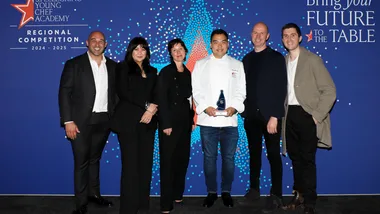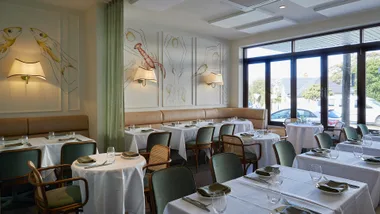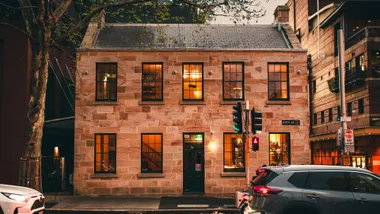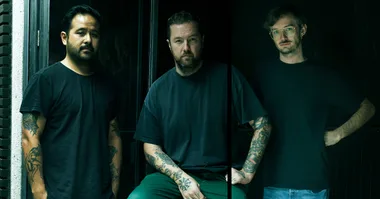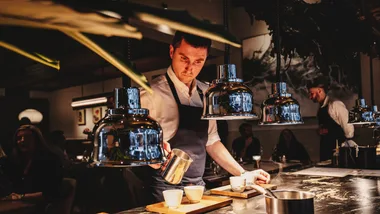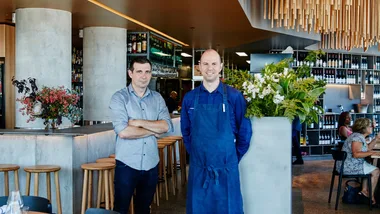I feel crazy, I feel excited, I feel happy. Of course, I’m nervous. For the past two months I’ve been waking up several times a night and probably it’s got something to do with the complexity of the project. This is not just a tiny little restaurant shack; it’s a little village that we’re building, which is so difficult the builders have had to invent techniques to make it.
It’s all in – if it doesn’t work out there’s nothing else. But I believe so much in this space. We’re in Christianshavn, away from the city, and situated right on a man-made lake that’s a bird sanctuary, and behind our property there’s a mound that’s part of the old fortification of medieval Copenhagen. With time this will be like one big overgrown garden with trees, plants, fruits, vegetables and these 11 buildings nestled in between. We’re even going to put in a sauna right on the lake. There are three greenhouses. The smallest will be tropical, and for the Aussies I’m proud to say we’ve ordered two finger limes, so we can have a bit of finger lime one day on the menu.

Sweet shrimps with last summer’s preserves
There was one concrete building on the property when we got hold of it, which was used to store marine equipment during World War II and was later abandoned. It’s 850 square metres with an 80 metre-long hallway and it’s the main engine room, housing staff rooms, places to grow stuff, places to hang out, places to experiment, an ant farm, tanks for live seafood like a Chinese restaurant, a room especially for game where we can hang a whole deer.
Then we’ve built seven new buildings from scratch and these are for guests. It sounds like “wow”, but one is only seven square metres. That’s the waiters’ room. Then there’s a separate entrance building, one for the restaurant, the bathrooms, a lounge building, one for barbecuing and a private dining room. They’re all connected by glass corridors.
The philosophy is to always feel like you are outdoors – that’s the main spirit here and it was something that came to us after we did our pop-up in Tulum last year. That was an outdoor restaurant with only the tree canopy above us. We’d planned to have skylights in this new space, but the main concept only solidified after we came home from Mexico. Then the question was how do you build a space that feels like you are outdoors all the time even though you live in a place where in all honesty the weather is so shitty seven months of the year.
Well, we feel we solved that in a pretty profound way. In the kitchen there’s a glass roof so the sky is right above us. From here you can oversee the different buildings in what we call the village, so it takes the cooks to the centre of everything. Everybody has to pass through the kitchen to go to the bathroom or the restaurant.

Queen clam with its own roe and blackcurrant wood fudge (bottom left), mahogany clam with preserved gooseberries, blackcurrant and mussel stock (bottom right), both from northern Norway.
The old Noma, in a 250-year-old building where the patina and energy were built in, was also an extraordinary place. I cried when we closed the doors to that space; many people did. It was emotional, but I also believe it was necessary because that Noma had become like a couch, a very comfortable couch that was getting more and more difficult to get up from. You felt good in it, you knew what to do, you knew everything, and so at one point I’m like, “No way man. I’m 40 years old. Let’s go, let’s do it again. It’s not time for a couch yet. Hopefully never.”
Sometimes you need to uproot everything.
The past year since we closed our old restaurant has been all about researching, travelling, exploring, connecting with people who we’ve been working with for the past 14 years, finding new friends, challenging our purveyors to do more, better, different, and see opportunity with the same-old same-old. We’ve been in my backyard and in my home kitchen because we weren’t ready here, and it’s the best creative period we’ve ever had. We are in new territory.

Horse mussels from the Faroe Islands (photo by @nomacph on Instagram)
Our menu will have three distinct seasons that we feel really fit our part of the world. In the cold months, like right now, we look towards the waters and serve only seafood, then when we go into the growing season, which typically starts in Scandinavia around June, we’ll have a vegetable menu and everything will change, even the ceramics we serve the food on. Then from early autumn to January it’s the game and forest season – the only time when meat will play a starring role.
The challenge was how do you shape something new out of the stuff you are so familiar with. It’s difficult. The octopus is the same, so is the squid, so are the carrots, and they’re from the same farmer. Having the focus of the three different seasons brought a great energy to the research and creativity.
We went on a journey, rather like when we went to Australia, and spent months travelling around the Nordics. It’s crucial. We shook hands and met yet again some of the divers and fishermen and the foragers and so on. But we also went deeper, diving into the ocean and looking at what’s there as opposed to what we thought before when we’d use lobster or turbot – luxury kind of stuff in a way. We discovered things in our waters and challenged ourselves to work with sea cucumbers, sea stars, jellyfish and such like, which we had never used. It’s such a basic idea but it yields so much. For that reason I feel like we have been able to squeeze out new things and see fresh opportunities.

Fresh lumpfish (photo by @reneredzepinoma on Instagram)
There’s a dish made from these giant sea snails from the Faroe Islands. They weigh maybe half a kilo each and we never really figured out how to cook them. Many times I’ve had this slimy thing in my hands and thought, “What are we going to do with this?” We tried to cook it like abalone the way we did in Australia, we looked at Japanese websites and watched YouTube after YouTube, but they always have that kind of chew. Then four months ago we started devoting time and energy to it and we found a way to cook that thing that’s made it one of the most delicious items we have on the menu. It has a similar quality to a simmered abalone, but there’s just more flavour and we’re serving it simply, sliced thin and tossed with these wild plants. You eat it as a salad from this wax cup that’s warm so it releases this honey-scent note that’s exactly what the dish needs. I love that serving and even more because it’s not just a theatrical element.
There’s a jellyfish serving as well that just melts on your tongue. It’s from Danish waters and it’s served with seaweed. When I talk about it, I don’t really love the idea of it. When we first tested it we thought it would be this weird-textured, slimy thing that’s hard to swallow, but once you get it in your mouth it holds until the heat of your tongue hits it and then it’s gone and this salty oyster rush hits. I’m very pleased with that one.
The energy I get from this creative work is paramount to how I live my life. Without that, I don’t know, there’s no way. This industry is way too hard to go to work and not have that creative rush and the sense of discovery, like the sense of achievement when you think, “Oh I’m actually shaping something new here, together and as a team.”

A cold-smoked abalone shell (photo by @reneredzepinoma on Instagram)
At the moment there are 50 people finalising all the small details. The dining room has huge wooden floorboards and a room divider made from wood that’s more than 200 years old, which was found in the waters a kilometre away from here. The patina is stunning. Some people would say this is not a fancy room, but I’m completely in love with it. One of the things that made it so difficult to build is that it’s lined with stacked wood rising five metres high. There are more than 250,000 screws and the carpenters really struggled to make it.
Everything had to be handmade in this project; it’s more important than being modern. One of the main concepts behind all of it is a sense of rawness – in the untreated oak chairs and tables and the room itself – which means you’re always looking at the beauty of the materials. This is a craft that we have chosen to do for a living so everything surrounding what’s on the plate should also have that feel to it. The quality of the materials, the quality of the ceramics or other products on the table and the quality of what you’re eating should all fit in with each other.
We have two beams with dried seaweed hanging from them, and we might hang up a few other elements. In the test kitchen we salted and air-dried 15 giant squid. They’re kind of pink, white and yellow at the same time. There’s a skull of a walrus with the big teeth still attached and we have an octopus that’s dried rock hard. We squished it and curled up the arms and painted it in its own ink. It’s beautiful, like a sculpture. Decorations like that, which are crafted or handmade with a story that relates to what we’re serving, we might put up somewhere. But what’s very important is that this restaurant space can never feel decorated – the building is the decoration.

The dining room at Noma
We are trying to make you feel comfortable and give you an exciting experience that tells you something about a certain place and a certain time. It’s been the premise ever since we started Noma in 2003, but I believe that we can achieve this in a fresh and new way. Everything we do is to make guests happy. I really truly want to make our guests happy. Honestly, it’s as basic as that. When that moment happens where there’s this explosion of joy and everybody seems to get exactly what you wanted to tell them – those nights you remember forever. You get high on it.
One reason why this building project was so complex was because it was built to change. A lot of people think I’m crazy when I say that, because we’re barely open. But how do we know what we want to do in 10 years or in five? Or, for that matter, when we’ve made it? You never truly arrive at the finish line – you are always either at the starting line or somewhere in between. Right now, finishing this project is the goal, but I know that very quickly I’ll need to have this uncertainty – I always have to have it – about what’s the next menu going to look like, how are we going to be able to continue to shape this place. The day that feeling is not there – that’s the day when it’s over.
Noma, Refshalevej 96, 1432, Copenhagen K, Denmark, noma.dk
Interview by Jeni Porter.

